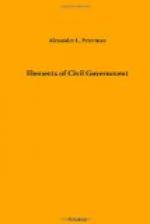The selling of a vote is regarded as one of the most infamous crimes that men can commit. Not even the conviction of theft so lowers a man in public esteem as a conviction of selling his vote, for bribery savors of both theft and treason. To sell his suffrage is to sell his manhood, his country, and his convictions. Most men who sell their votes do it through ignorance; they are not aware of the enormity of the crime. He who knows its infamy, and yet barters his suffrage for money, is unworthy of the smallest trust, or even of the recognition of honest men.
[1]For details regarding this system see Chapter XIX.
SUGGESTIVE QUESTIONS.
1. In what way are voters responsible for the government of the country?
2. Do you believe in frequent elections? Why?
3. Do you believe in public voting or in secret voting? Why?
4. Why should election officers be fair and honest men?
5. What do you think of vote-buying and vote-selling?
CHAPTER XIX.
THE AUSTRALIAN BALLOT SYSTEM.
ORIGIN.—The idea of the secret ballot system, now known under its various modifications as the Australian Ballot System, was first proposed by Francis S. Dutton, member of the legislature of South Australia from 1851 to 1865. At that time the vices frequently accompanying open elections had begun to flourish in Australia. Bribery, intimidation, disorder, and violence were the order of all election days. The plan was elaborated, and became a law under the name of the “Elections Act” in 1857.
The beneficial results of this method soon became evident to other countries, and the movement spread to Europe, Canada, and the United States.
IN THE UNITED STATES.—A similar system to that originally adopted in Australia was first introduced into the United States by its adoption in 1888 in the State of Massachusetts and in the city of Louisville, Kentucky. The next year the legislatures of Indiana, Montana, Rhode Island, Wisconsin, Tennessee, Minnesota, Missouri, Michigan, and Connecticut passed laws providing for new systems of voting, more or less resembling the Australian system; and now their example has been followed by almost all the other States.
PRINCIPLES.—Although there are many modifications of detail in the statutes of the various States, there are two essential features of the ballot-reform system which are everywhere observed:
First, An arrangement of polling, by which compulsory secrecy of voting is secured, and intimidation or corruption of voters is prevented.
Second, One or more official ballots, printed and distributed under authority, on which the names of all candidates are found.
REQUIREMENTS.—The following are the requirements of the system: Ballots must be provided by public expense, and none but these ballots may be used. On these ballots should be printed the names of all candidates who have been nominated previously to the election, with the names of the offices for which they have been nominated and of the parties they represent.




